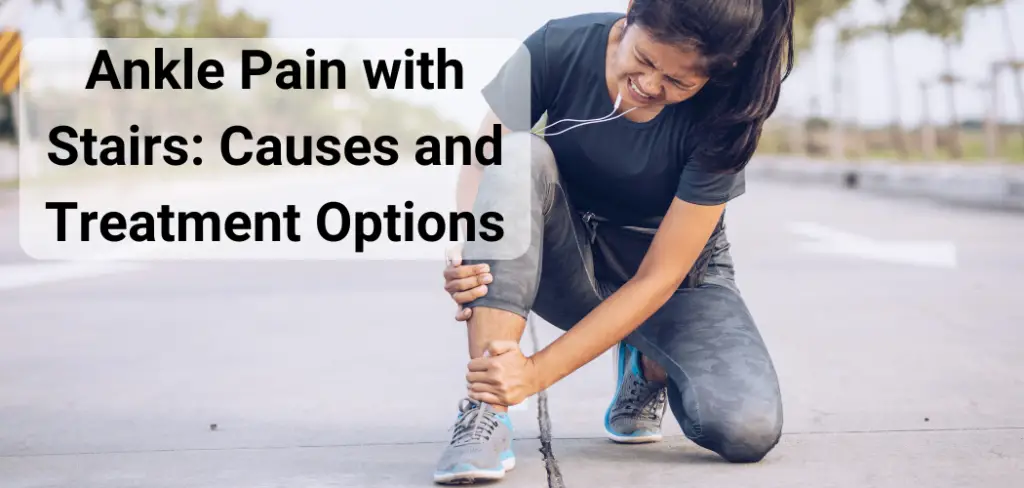You’re not alone if you experience ankle pain when walking up or down stairs. This is a common problem for people of all ages, but especially for athletes and older adults. It can be frustrating to the point that you want to avoid stairs altogether.

However, there are stairs all over town or maybe even a flight of stairs in your house, and we don’t want you to think twice about using them. For instance, our local post office has a solid set of 15 steps to enter the building. With a bit of knowledge and effort, you can address your ankle pain in no time.
Several potential causes of ankle pain exist, but fortunately, some straightforward treatments can help. Keep reading to learn more about the various causes of ankle pain felt with stairs and what you can do to find relief.
Pain on the Front of the Ankle with Stairs
Pain in the ankle can be daunting and frustrating if left untreated. One particular cause of ankle pain can be anterior ankle impingement when a certain part of the ankle joint becomes too tight due to arthritis or other factors. Some of this includes tight calf muscles, arthritis changes in the ankle joint, or changes in swelling.
This is most commonly caused after an injury, and the resulting inflammation restricts the motion of the ankle bones. The hypomobility in the ankle bone causes some of the soft tissue in the front of the ankle to be “pinched” with the joint.
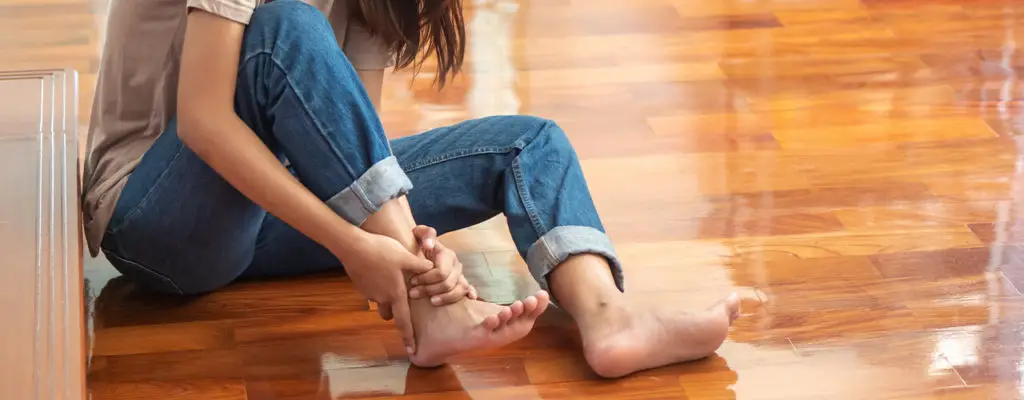
It can become sore during specific movements, such as kneeling, and even worse with activities like going downstairs. This type of condition is most commonly found in elderly populations where osteoarthritis is more common. Ankle impairments like this develop slowly over time but can also happen right after an injury to the ankle or the lower leg.
It should never be taken lightly, and treatment should be initiated early to reduce the chances of chronic ankle limitation.
How to Treat Anterior Ankle Pain
Anterior ankle pain can be a frustrating experience for those looking to return to an active lifestyle. Fortunately, there are a few methods that you can use to reduce discomfort and strengthen the muscles around your ankle.
One of the most important ways to treat anterior ankle pain is through stretching. Start by doing calf stretches while seated and progress further by standing on one foot on the edge of a stair.
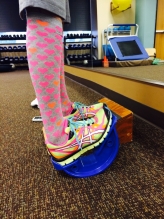
Additionally, it can help to roll out any tension or knots in your calf by using a foam roller or tennis ball. By sitting on the ground and using the foam roller or tennis ball to massage and or perform “myofascial release,” you can reduce the muscular guarding on the lower leg and improve ankle motion.
The other way to improve ankle mobility, and quite possibly, the most important thing to focus on, is to improve the restriction of the joint itself. The ankle joint can become stiff and prevent ankle dorsiflexion. There are many great exercises to improve ankle dorsiflexion, but some of our favorites include the knee-to-wall stretch and banded ankle mobilizations.
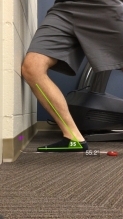
Another effective way to reduce anterior ankle pain is by strengthening the muscles around your ankle joint. This includes activities such as heel raises, single-leg balancing exercises, cable-resisted exercises, and planks with dorsiflexion (pulling your toes towards you). By strengthening these stabilizing muscles, you will decrease the risk of developing and exacerbating existing injuries.
Pain on the Outside of the Ankle with Stairs
Pain on the outside of the ankle is a common complaint among men and women of all ages, from athletes to everyday individuals. In most cases, these ankle pains are caused by ankle sprains incurred from activities such as sports, running, or even simple day-to-day activities.
Ankle sprains are stretching or tearing of the ligaments and tendons on the outside of the ankle joint. This can result in ongoing weakness in the ankle muscles due to repeated sprains.
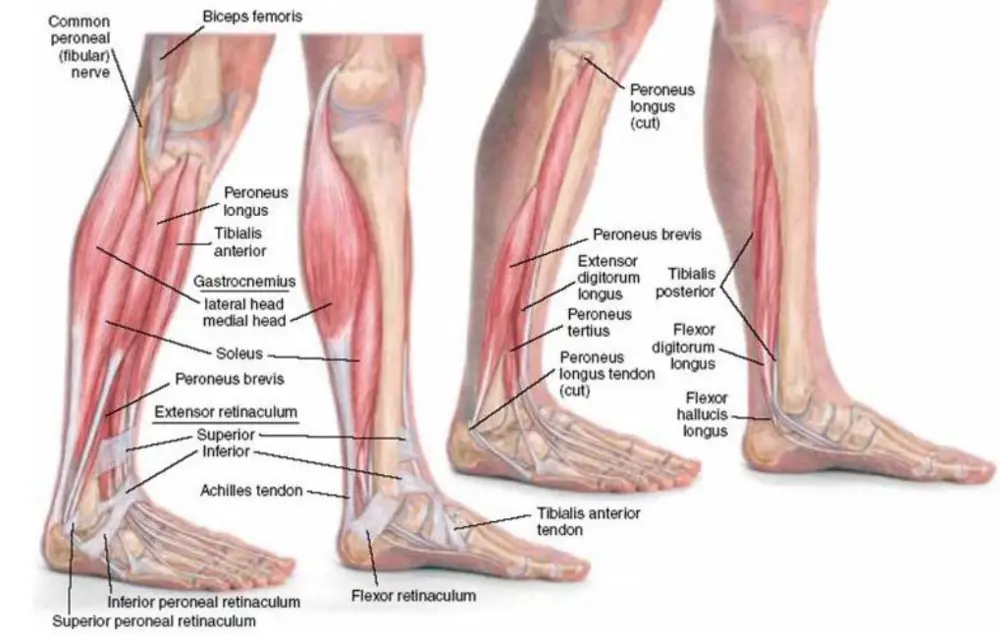
Two important muscles involved in ankle stability, movements, and strength are Peroneus Longus and Brevis; they are located at the lateral aspect (outside) of the ankle joint and help provide additional stability to the ankle.
It’s crucial that if you experience an ankle sprain, you take it seriously and try to rehab and strengthen the ankle as much as possible. We tend to downplay the seriousness of a lateral ankle sprain but left untreated, and it can develop into Chronic Ankle Instability, leading to a multitude of issues later on in life.
How to Treat Lateral Ankle Pain
Lateral ankle pain is an unfortunately common side effect of an ankle sprain. Thankfully, stretching and strengthening exercises can be used to reduce the severity and duration of discomfort.
When treating lateral ankle pain due to an ankle sprain, it is important to regain your range of motion as quickly as possible.
Start with a gentle stretch. You can start stretching immediately after a sprain with light stretching, such as stretching by placing a towel around your foot and using it as a lever to increase tension. It’s also important to stretch the ankle in motions where your foot is pointing away from your shin into plantarflexion which helps restore normal ankle bone kinematics.
Alongside stretching, it is important to strengthen the muscles around your ankle joint in order to reduce lateral ankle pain. Once the ligaments and tendons get stretched, the ankle is less stable and requires muscle strength to help stabilize the joint.
Resistance band exercises are a great way to strengthen the muscles around your ankle joint. They are inexpensive and can provide a wide range of resistance that is great for training and strengthening the muscles.
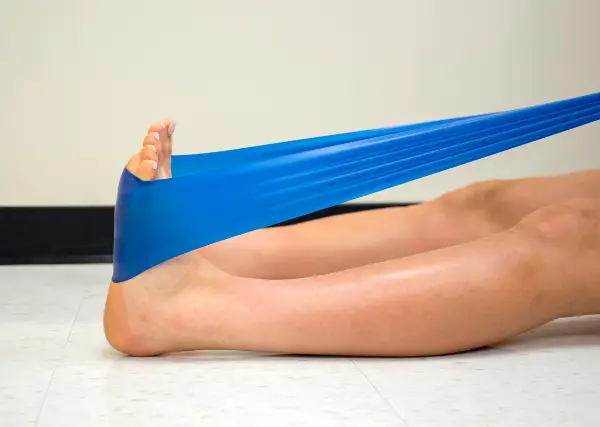
Exercises using resistance bands include 4-way ankle resistance exercises, lateral and forward walks, toe taps, balance training, and calf raises. These exercises should be done slowly and with control in order to target the muscles effectively.
Additionally, ensure that you have chosen a band that provides adequate resistance – you should feel fatigued after 8-12 repetitions.
Once you have mastered resistance band exercises for the ankle, you’ll need to make sure that you move on to more challenging exercises. This includes single-leg balance, single-leg calf raises, single-leg plyometrics, and multi-joint movements such as a split squat.
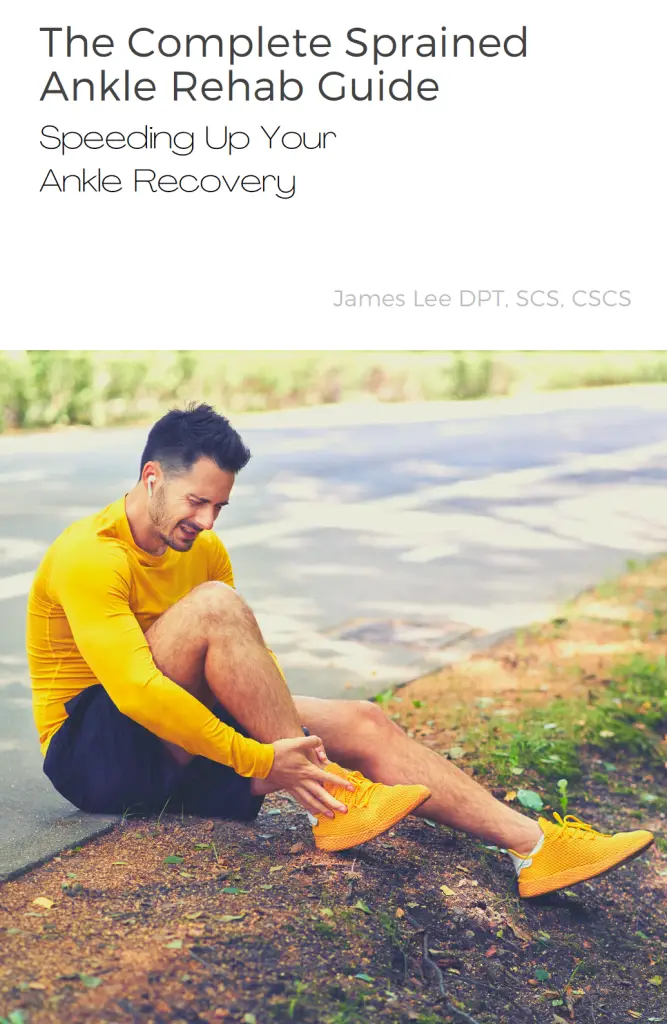
Want to make a full recovery after a sprained ankle? Need to get out of pain? See our complete sprained ankle rehab guide for a self-guided recovery through all the critical phases.
Improving strength and stability in these muscles will reduce the risk of re-injuring yourself again in the future and reduce the risk of chronic dysfunction such as developing arthritis.
Pain on the Back of the Ankle with Stairs
Achilles tendonitis can be a major source of pain in the back of the ankle, and it can worsen with stair climbing. Most of the time, Achilles Tendonitis will have a gradual onset that starts as minor and, when left untreated, develops into something much worse and painful.
In order to manage Achilles tendonitis, regular exercises specifically targeting the Achilles tendon and lower leg muscles are necessary. Achilles tendonitis is caused by micro-tearing of the tendon, which leaves it weak and more vulnerable to further aggravation.
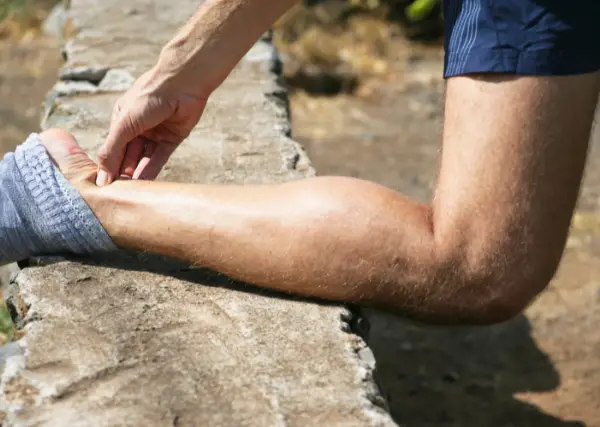
Achilles tendon pain is often, but not always, exacerbated by poor foot control during walking. If the foot falls into more pronation, or a flat foot position with no arch support, it can put additional strain on the medial side of the Achilles tendon. Each step into that foot’s flat position pulls on the tendon, aggravating any injury already present.
How to Treat Achille Tendonitis Ankle Pain
Achilles tendonitis is a painful condition caused by overuse or injury to the Achilles tendon. To reduce the pain associated with this condition, light calf stretches using a towel can help to restore flexibility in the tendon while strengthening exercises can reduce the risk of further re-injury.
To stretch your calf, lie down on your back with your leg straight out in front of you. Place a towel around the ball of your foot and gently pull it towards you, holding the stretch for 30 seconds or longer. Repeat this stretch several times throughout the day, always making sure not to push into any sudden or sharp pain during the stretch.
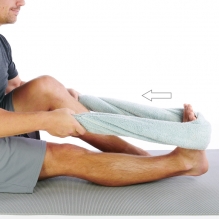
We prefer to do this stretch in a non-weight-bearing position to obtain a stretch without having too much force on the tendon and creating more tears, such as when you do a runner’s stretch in standing.
In addition to stretching, strengthening exercises such as single-leg balances and eccentric calf raises can help add stability to the tendon and reduce pain. Eccentric calf raises are an excellent way to strengthen the muscles of your calves and the Achilles tendon.
To perform an eccentric calf raise, stand with both feet on the edge of a raised surface, such as a step or platform. Lift your heel off the platform, raising it to your toes, and then slowly lowering it back down for a full repetition. The key here is to perform the exercise in a controlled manner, to load the Achilles throughout the motion. When done correctly, eccentric calf raises help build strength in all parts of the calves and can be useful for injury prevention and improved performance.
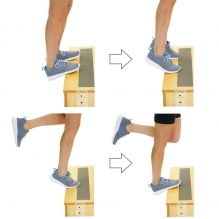
In some cases of Achilles tendonitis, wearing an over-the-counter insole can also reduce pressure on the affected area. An insole provides cushioning for the heel and, more importantly, prevents the arch from collapsing medially. This reduces tension transferred to the inside of the Achilles, supports it from being stretched repetitively, and allows for healing.
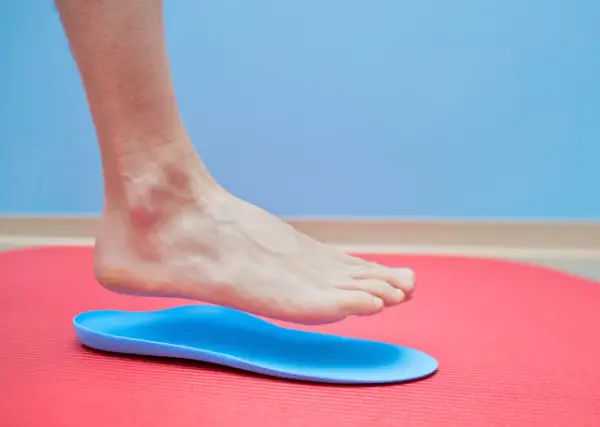
Pain on the Inside of the Ankle
Pain on the inside of the ankle can be quite bothersome and is typically caused by weakness in the Tibialis Posterior and the other ankle inverters. These muscles support the arch of the foot as we stand and walk.
Most people get the shape of their arch from genetics, but as people age or after a period of overuse, the Tibialis Posterior can weaken, causing the arch height to decrease. Eventually, this may lead to Tibialis Posterior tendonitis, which causes considerable pain around the inside of the ankle joint.
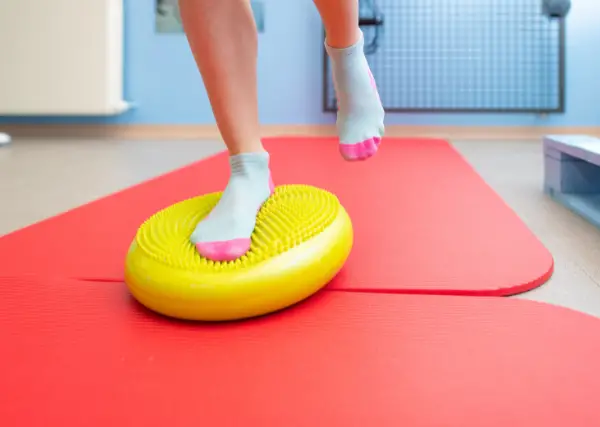
It’s essential to exercise the Tibialis Posterior and the other muscles on the inside of the shin to keep its strength up in order to avoid discomfort and risk of further injury around the ankle joint.
Dysfunction of the Tibialis Posterior also causes Shin Splints. Shin Splints refer to pain along the inner aspect of the shin bone (tibia) and can be caused by overtraining, running on uneven surfaces, pronation issues, or tight calves.
How to Treat Medial Ankle Pain
Tibialis Posterior tendonitis is an inflammation and micro-tearing of the tendon that connects the deep calf muscles to the bones in the foot. It’s an injury that occurs when someone does too much after too little activity for an extended period of time.
Treating the Tibialis Posterior requires a combination of strength training, balance exercises, and temporary external support such as taping or bracing is essential to address the pain and discomfort.
Rest actually doesn’t help much with tendonitis. So while reduced activity is necessary to decrease pain, rest alone will not help heal tendonitis.
Strength training helps build muscle resiliency and helps start the tendon repair process. Strengthening builds the tendon up bigger and stronger, resulting in less pain. Some of our favorite exercises for this are double leg calf raises with a ball between the ankles and single leg balance with the knee bent, trying to drive the knee forward.
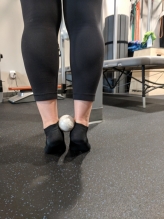
Balancing on a single leg is a great way to improve muscle endurance and strength. This improves strength and makes the muscles of the lower leg and foot have to work to control the arch of the foot and maintain balance. Some of our favorite balance exercises for this include balancing single-leg on a Bosu ball or on a foam pad.
Finally, taping may provide additional support for your tendons, allowing them to actively perform their normal duties without causing re-aggravation. Taping is a temporary solution until you can build enough strength in the lower leg to address the tendonitis.
An ankle brace, such as a lace-up ankle brace, is also an option/alternative to taping. This type of brace will provide compression and support to the area while still allowing normal movement.
Conclusion
In conclusion, ankle pain that is worse during stairs is a prevalent but varied condition that can be caused by a multitude of issues.
It is important first to assess the location of your pain in order to begin narrowing down the potential causes. Once you know where your pain stems from, you can start seeking specific treatments and therapies to help alleviate discomfort.
Ankle pain shouldn’t be ignored or something you have to live with. Many helpful home treatments are available once you know the causes and location.
If you are unsure about the source of your ankle pain or want more information on treatment options, please don’t hesitate to contact our team of experts for guidance. Let us know in the comments if you have any favorite ankle exercises.
Disclaimer: The information provided in this post is for educational purposes only. This is not a substitute for a medical appointment. Please refer to your physician before starting any exercise program.
